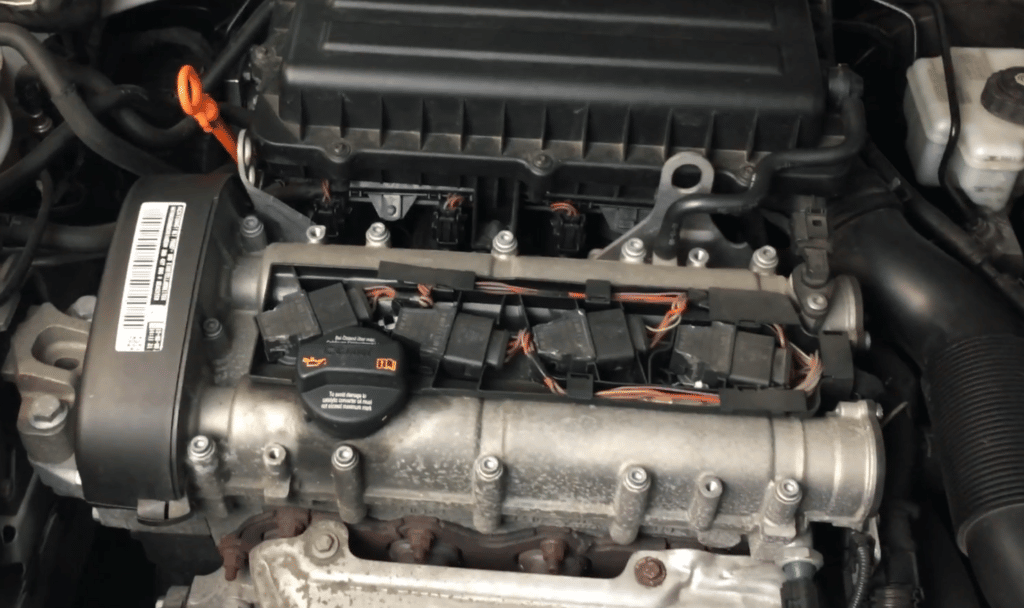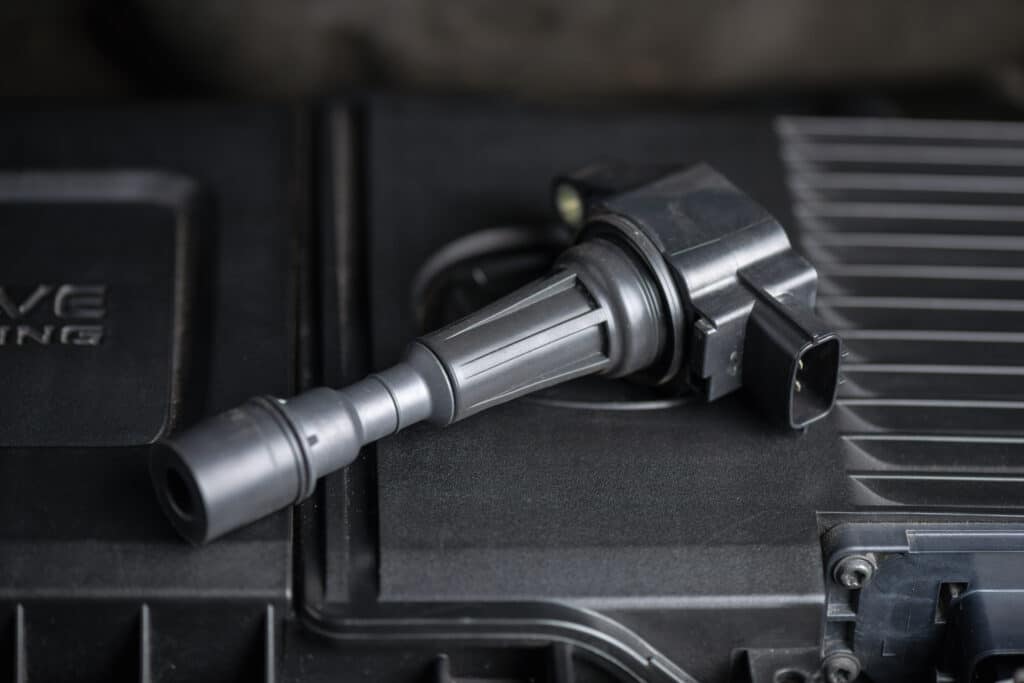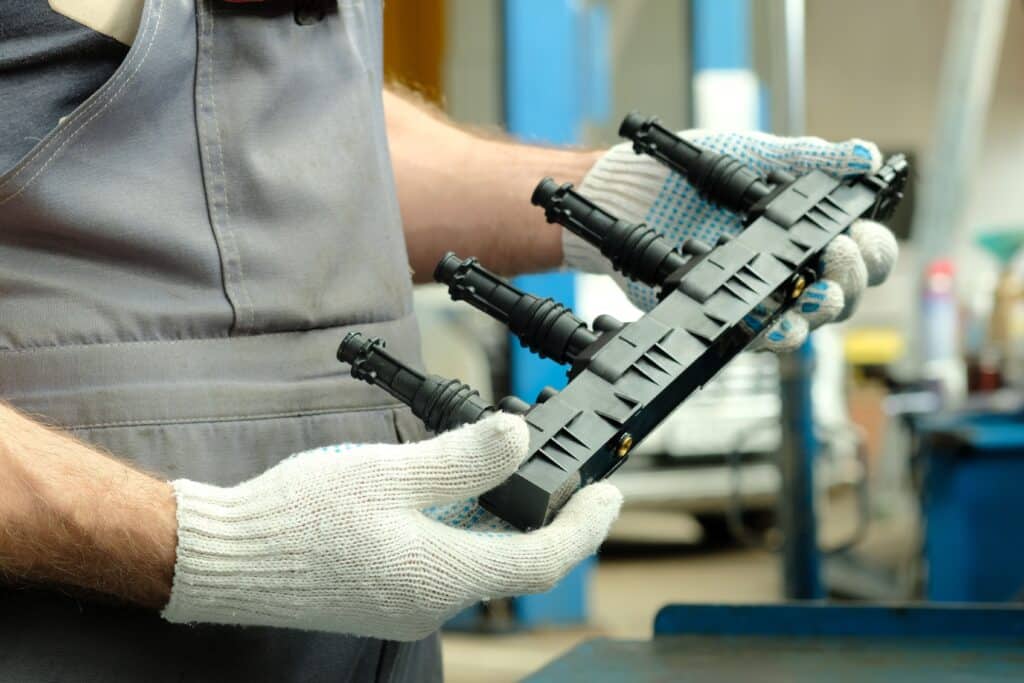You want to know how an ignition coil works? With this page you will better understand your ignition system.
What is the function of the ignition system/ignition coil?

In general, the term “ignition” is understood to mean the ignition of the air-fuel mixture.
For gasoline engines, the ignition system is necessary for this. This is because, unlike a diesel engine (self-igniter), the gasoline engine (spark igniter) cannot ignite this mixture itself. No ignition system is necessary for diesel engines, since the diesel engine ignites itself, as already mentioned.
How does an ignition coil work?
The main task of the ignition coil is to transform the on-board voltage of 12V available in the vehicle to the required ignition voltage and then passed on to the spark plug.
Basically, the function of the ignition coil is relatively simple to explain. The ignition coil itself contains a primary and a secondary winding. The primary winding has very few turns, while the secondary winding has very many.
As soon as the engine control unit sends a signal to the ignition coil, the on-board voltage of 12V flows through the primary winding. Through this process, a magnetic field is built up. As soon as the signal from the engine control unit is interrupted again, this magnetic field is abruptly reduced. This abrupt degradation generates a high voltage in the secondary winding. This high voltage is now transmitted to the spark plug, which consequently generates a spark.
Different designs of an ignition coil
Block ignition coil

As the name suggests, a block ignition coil is constructed like a block. In this case, several ignition coils are installed in one block and are combined. The spark plugs are connected via the block ignition coil using ignition cables.
Block ignition coils are available in a version with single or double spark technology. In some cases, the ignition output stage may also be integrated in the block ignition coil.
Ignition Coil

Single ignition coils or also called plug well ignition coils are plugged directly onto the spark plug in the spark plug well. This means that each spark plug has its own ignition coil, which is controlled directly by the engine control unit.
This type of ignition coil is the most commonly installed in more modern vehicles today. This is because the advantage over other types of ignition coils is that the ignition energy can be transferred to the spark plug with virtually no loss.
In addition, because of the design of the ignition coil, space can be saved, because there is usually a spark plug well.
Coil-pack

As with the ignition coil pack, several ignition coils are combined in one component in an ignition coil strip.
However, the ignition coil strip is plugged directly onto the spark plugs, as with the single ignition coil.
This type of ignition coils is still partly installed, but much less than the single ignition coil.
how to test ignition coil?
How to test ignition coil without multimeter?
The best and easiest test for this fault is to replace the ignition coil crosswise. This means that you take the faulty ignition coil from the cylinder that is stored in the fault memory and install it on another cylinder. In turn, the ignition coil from the latter cylinder is installed on the previously faulty cylinder. When this is done, the fault memory should be cleared and a test drive made until the fault reappears. Then the vehicle should be read out again. If the error has now migrated to the other cylinder, this means that this ignition coil is really defective. If the error has not migrated, the same must be tested with the spark plug. Here, too, a test drive must be carried out again and then the fault re-evaluated.
How to test ignition coil with multimeter?
To check the ignition coil with a multimeter, it should be removed for better accessibility.
Since the PIN assignment of the ignition coil can vary for each vehicle and manufacturer, a circuit diagram of the vehicle should be available in advance.
To test the ignition coil, the multimeter must be set to “Resistance”.
The primary winding should have a resistance value of 0.5 – 2.0 ohms. If the value is significantly higher or lower, it can be assumed that the ignition coil is defective.
The secondary winding should have a resistance value of 8 – 15 KOhm. This is the same as for the primary winding. If the resistance value is higher or lower than the specified value, the ignition coil is defective.
How often should be replaced the ignition coil replacement?
The service life of an ignition coil depends on several factors such as driving style, the maintenance condition of the vehicle and the type of ignition coil. On average, the service life of an ignition coil is between 60,000 and 100,000 kilometers. However, a regular maintenance check can help to extend the service life.
How much does an ignition coil cost?
In the case of faults in the ignition system or ignition coil, it can usually be assumed that the repair costs will remain manageable.
Normally, an ignition coil costs about 30-50 euros. Of course, there are also individual cases where an ignition coil can also cost up to 200-300 euros.
In addition, in the event of a defective ignition coil, we also advise replacing the remaining ignition coils in the same course.
Nevertheless, thorough troubleshooting should be performed to avoid unnecessary costs.
Can I change an ignition coil myself?
As a rule, ignition coils are easy to change and do not require special tools. In this video you can see how to change the ignition coils on a vehicle using a VW/Audi as an example.

